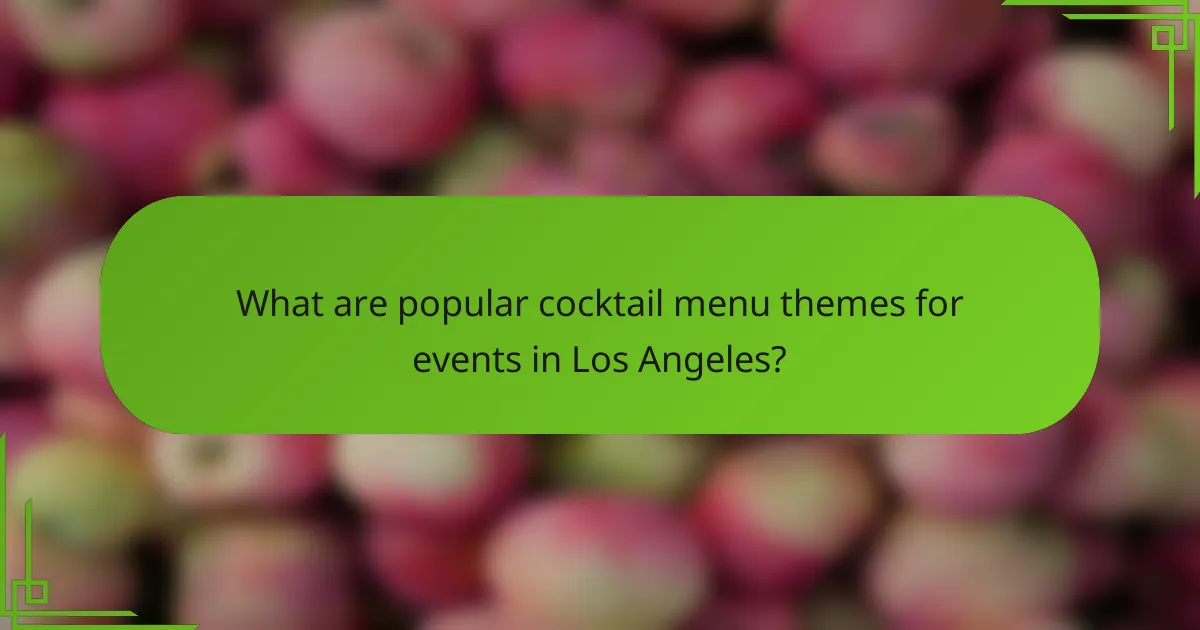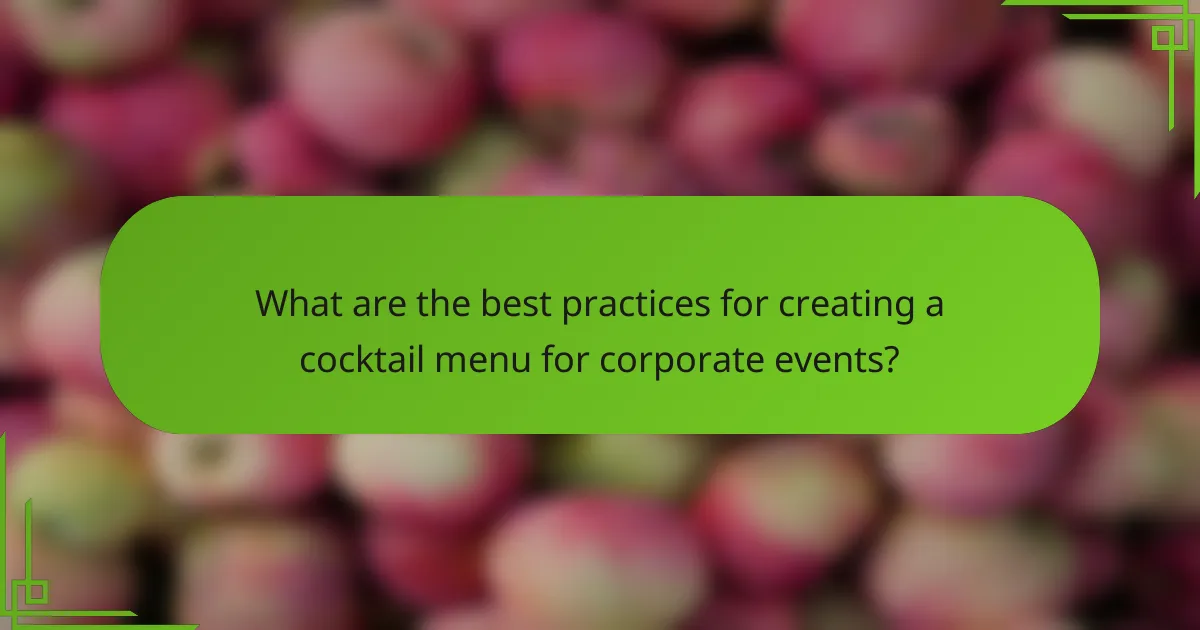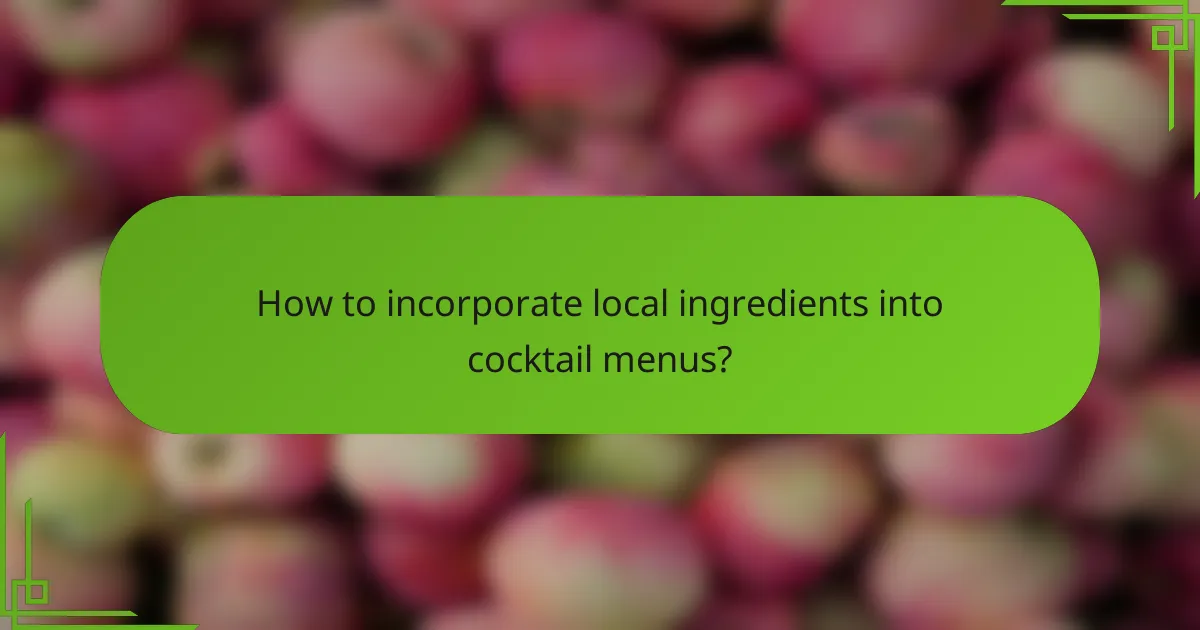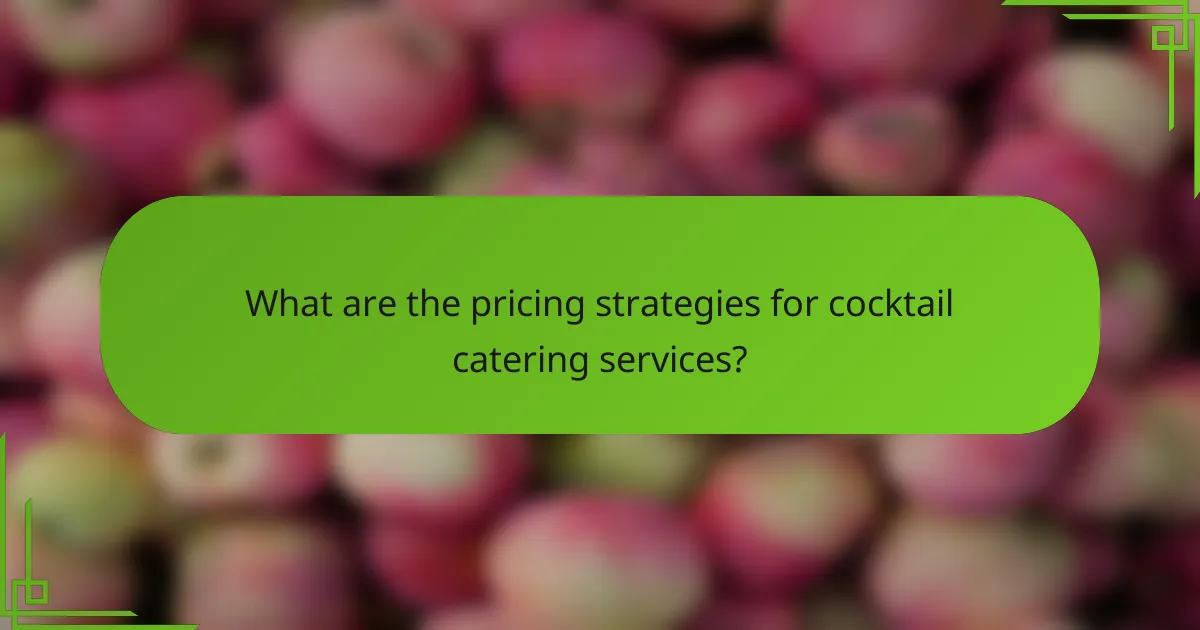Catering cocktail menus for events requires a thoughtful approach that reflects the occasion and resonates with guest preferences. In vibrant cities like Los Angeles, themes often draw from diverse cultural influences, making it essential to engage with guests beforehand to curate selections that cater to their tastes and dietary needs. Whether for corporate gatherings or social celebrations, a well-crafted cocktail menu enhances the overall experience and aligns with the event’s identity.

What are popular cocktail menu themes for events in Los Angeles?
In Los Angeles, popular cocktail menu themes often reflect the city’s vibrant culture and diverse influences. Event planners typically choose themes that resonate with the occasion and cater to guest preferences, ensuring a memorable experience.
Classic Hollywood Glamour
The Classic Hollywood Glamour theme evokes the elegance of the golden age of cinema. Signature cocktails might include martinis, champagne cocktails, and classic Manhattans, served in vintage glassware to enhance the nostalgic feel.
To create this ambiance, consider incorporating elements like red carpets, art deco decorations, and black-tie attire for guests. This theme is perfect for upscale events such as weddings or corporate galas.
Tropical Luau
A Tropical Luau theme brings a fun, festive atmosphere to any event. Cocktails typically feature rum, fresh fruit juices, and tropical garnishes, such as pineapple and umbrellas, creating a vibrant and colorful presentation.
For authenticity, consider adding tiki torches, leis, and Hawaiian-inspired decor. This theme works well for summer parties, outdoor gatherings, or casual celebrations, appealing to guests looking for a relaxed vibe.
Rustic Farmhouse
The Rustic Farmhouse theme emphasizes natural elements and a cozy atmosphere. Cocktails often include local spirits, seasonal fruits, and herbs, reflecting the farm-to-table movement that is popular in California.
Decor can feature wooden tables, mason jars, and wildflowers to enhance the rustic charm. This theme is ideal for outdoor weddings, barn receptions, or intimate gatherings, appealing to guests who appreciate simplicity and authenticity.
Modern Minimalist
The Modern Minimalist theme focuses on clean lines and simplicity. Cocktails in this category often feature fewer ingredients, emphasizing quality over quantity, with drinks like gin and tonics or simple spritzers.
To achieve this look, use sleek glassware and a monochromatic color palette in decor. This theme suits contemporary events, art openings, or corporate functions, appealing to guests who favor sophistication without excess.
Seasonal Harvest
The Seasonal Harvest theme celebrates the flavors of each season, using fresh, locally sourced ingredients. Cocktails can include flavors like apple cider in the fall or fresh berries in the summer, creating a connection to the time of year.
Incorporate seasonal decorations, such as pumpkins in autumn or flowers in spring, to enhance the theme. This approach is perfect for farm-to-table events, holiday parties, or any gathering that values sustainability and freshness.

How to tailor cocktail menus to guest preferences?
To tailor cocktail menus effectively to guest preferences, consider their tastes, dietary restrictions, and the event theme. Engaging with guests before the event can help you curate a selection that resonates well with them.
Signature Cocktails
Signature cocktails add a personal touch to your event, reflecting its theme or the host’s personality. Choose a few standout drinks that can be easily replicated, ensuring they appeal to a broad audience while still being unique.
Consider using local ingredients or flavors to enhance the connection with your venue. For example, a cocktail featuring regional spirits or seasonal fruits can create a memorable experience.
Mocktail Options
Including mocktail options is essential for accommodating non-drinkers and those who prefer lighter beverages. Offer at least two to three creative non-alcoholic choices that are just as appealing as their alcoholic counterparts.
Utilize fresh juices, herbs, and flavored syrups to craft mocktails that are vibrant and flavorful. Examples include a virgin mojito with mint and lime or a berry spritzer with soda and fresh fruit.
Dietary Considerations
Be mindful of dietary restrictions when designing your cocktail menu. Common considerations include allergies, gluten intolerance, and vegan preferences. Clearly label drinks that contain allergens or animal products.
Offering a variety of options ensures that all guests feel included. For instance, use gluten-free spirits and offer cocktails made with fresh fruits and herbs to cater to diverse dietary needs.
Flavor Profiles
Understanding flavor profiles is crucial for crafting a balanced cocktail menu. Consider incorporating a mix of sweet, sour, bitter, and savory elements to cater to different palates.
For example, a cocktail with citrus notes can be refreshing, while one with herbal or spicy undertones can add complexity. Aim for a range of flavors to keep guests engaged and satisfied throughout the event.

What are the best practices for creating a cocktail menu for corporate events?
Creating a cocktail menu for corporate events involves aligning the offerings with the brand identity while ensuring a professional presentation and efficient service. Focus on guest preferences and event themes to enhance the overall experience.
Branding Alignment
Ensure that the cocktail menu reflects the company’s brand identity, including color schemes, logos, and overall messaging. This can be achieved by naming cocktails after company values or using ingredients that resonate with the brand’s ethos.
For example, a tech company might feature cocktails with innovative names or futuristic ingredients, while a luxury brand could opt for premium spirits and elegant garnishes. Consistency in branding helps reinforce the company’s image and creates a memorable experience for guests.
Professional Presentation
A well-presented cocktail menu enhances the overall aesthetic of the event. Use high-quality materials for printed menus and consider digital options for a modern touch. Ensure that the menu is easy to read, with clear descriptions of each cocktail.
Incorporate visuals, such as images of the cocktails or themed graphics, to entice guests. Additionally, consider the layout of the bar area to facilitate a seamless flow, making it easy for guests to view and select their drinks.
Efficient Service
Efficient service is crucial for maintaining a positive atmosphere at corporate events. Train staff to be knowledgeable about the cocktail menu, enabling them to make recommendations and serve drinks promptly. Consider having a limited selection of cocktails to streamline the preparation process.
Implementing a pre-order system for cocktails can also reduce wait times, allowing guests to enjoy their drinks without delays. Ensure that the bar setup allows for quick access to ingredients and tools, which will help staff serve efficiently during peak times.

How to incorporate local ingredients into cocktail menus?
Incorporating local ingredients into cocktail menus enhances flavor and supports regional agriculture. By using locally sourced items, you can create unique drinks that resonate with the local culture and appeal to guests’ preferences.
Farm-to-Table Spirits
Farm-to-table spirits focus on using ingredients sourced directly from local farms, ensuring freshness and quality. Look for distilleries that emphasize organic grains or fruits grown nearby, which can elevate the taste of your cocktails.
When selecting farm-to-table spirits, consider the seasonal availability of ingredients. This approach not only supports local economies but also allows for creative cocktail variations that change throughout the year.
Seasonal Fruits and Herbs
Using seasonal fruits and herbs in cocktails can significantly enhance their flavor profile. For example, summer cocktails might feature fresh berries or citrus, while fall drinks could incorporate apples or spices.
To effectively incorporate seasonal ingredients, create a rotating cocktail menu that highlights what is currently available. This keeps the offerings fresh and encourages guests to try new flavors that reflect the time of year.
Local Distilleries
Partnering with local distilleries can provide unique spirits that are not widely available, adding a distinctive touch to your cocktail menu. Research distilleries in your area that produce gin, vodka, or whiskey, and consider featuring their products prominently.
When collaborating with local distilleries, consider hosting tasting events or cocktail classes to engage guests. This not only promotes the spirits but also builds a community around local producers, enhancing the overall experience for your patrons.

What are the pricing strategies for cocktail catering services?
Cocktail catering services typically employ various pricing strategies to accommodate different event needs and budgets. Understanding these strategies can help you choose the best option for your event while ensuring you meet guest preferences and theme requirements.
Per-Person Pricing
Per-person pricing is a common strategy where costs are calculated based on the number of guests. This model allows for straightforward budgeting, as you can easily estimate total costs by multiplying the price per person by your expected attendance.
Prices can vary significantly based on the complexity of the cocktail menu and the quality of ingredients. Generally, you might expect rates to range from $15 to $50 per person, depending on the selection and service level.
Package Deals
Package deals offer a bundled pricing approach, combining various services and menu options into a single price. These packages often include a set number of cocktails, mixers, garnishes, and sometimes even staff service.
Choosing a package can simplify planning and may provide savings compared to selecting items individually. Typical packages might start around $300 for small gatherings and can exceed $1,500 for larger events with extensive offerings.
Premium Add-Ons
Premium add-ons enhance the cocktail catering experience by offering higher-end options, such as specialty cocktails, unique garnishes, or premium spirits. These enhancements can elevate the overall event atmosphere and impress guests.
When considering premium add-ons, be aware that they can significantly increase your total costs. For instance, adding a signature cocktail or high-quality liquor might add $5 to $15 per person, depending on the choice. It’s essential to balance these options with your budget and guest preferences.

How to ensure compliance with local alcohol regulations?
To ensure compliance with local alcohol regulations, familiarize yourself with the specific laws governing alcohol service in your area. This includes understanding licensing requirements, age restrictions, and service limits to avoid legal issues during your event.
Understand local licensing requirements
Each locality has its own licensing requirements for serving alcohol at events. Check if you need a temporary event permit or if your venue already holds a valid license. In some regions, you may need to apply for a special license weeks in advance, so plan accordingly.
For example, in the United States, many states require a specific permit for serving alcohol at private events, while others may allow it under a general business license. Always verify with local authorities to ensure compliance.
Know the age restrictions
Age restrictions for alcohol service vary by location, typically requiring servers to check IDs to confirm guests are of legal drinking age. In many places, this age is 21 years, but some countries may have different regulations.
Implementing a strict ID-checking policy can help avoid fines and legal issues. Train your staff on how to properly check identification and handle situations where guests cannot provide valid proof of age.
Limit alcohol service responsibly
Responsible alcohol service is crucial for compliance and guest safety. Set clear limits on the amount of alcohol served, and consider offering a range of non-alcoholic options. This not only helps manage consumption but also caters to guests who prefer not to drink.
Establishing a cut-off time for alcohol service, such as an hour before the event ends, can help prevent overconsumption. Additionally, consider hiring professional bartenders who are trained in responsible service practices to further ensure compliance and safety.


